Can ordinary people tell the difference between natural diamonds and artificial diamonds?

|
Review expert: Gan Qiang, lecturer at Beijing Institute of Technology, PhD in Applied Chemistry "Diamonds are forever", this slogan gives diamonds the meaning of symbolizing eternal love. It is also this slogan that makes diamond rings replace other jewelry and become the ideal love token for newlyweds. Have you ever wondered why diamonds, which are supposed to be transparent, often shine with bright white light and faint rainbow light? Of course, not all diamonds are very expensive. Natural diamonds also have "cheap substitutes". Next, let us enter the world of diamonds, understand the secrets of diamonds' brilliance, and explore the current market options. Source: a brand advertisement Evolution of Diamond Cutting Technology The secret of diamond's brilliance lies in its cutting process. From the evolution of cutting technology, we can see the reason why diamonds gradually shine. Modern craftsmen polish diamonds source 丨 SOTHEBY'S Diamond, also known as diamond, is the hardest natural material known in nature, which also makes it very difficult to cut and process diamonds. 4,000 years ago, the world's first natural diamond was discovered in India. For a long time after that, diamonds were preserved in their natural state. It was not until the 15th century that the technology of diamond cutting and processing began to develop, and the technology of diamonds "cutting themselves" was initially developed. Belgian Ludwik van Berken mixed olive oil with diamond powder and invented a diamond polishing wheel called a Scaif. Natural diamond processing machine source | AWDC The diamond is rubbed against a grinding wheel with diamonds, and the two wear out in the same proportion, thus achieving "cutting itself". This technology requires another diamond of the same hardness to be consumed for each natural diamond cut, but it also reduces the difficulty of diamond processing, improves the precision of cutting, and allows craftsmen to have more choices in appearance and cut surface. Schematic diagram of an octahedral crystal made with a grinding wheel (first from left) Source: Sanaeya Yezad Daruvala Based on the continuous maturity of cutting techniques such as "grinding disc", the technology of diamond cutting has gradually enriched and evolved. The "rose cut" appeared in the 16th century. This cut is characterized by a domed top and a flat bottom. Source: natural dimaonds The "Mazarin Cut" in the 17th century put more effort into the cutting surface and initially explored the "brilliant cut". Through dozens of facets at different angles but overall symmetry, the diamond flashes a strong white light under the light. Source: natural diamonds In the 19th century, the two industrial revolutions brought steam and electrical power. In the 1930s, the rise and development of laser cutting technology promoted the transformation of the diamond cutting field, and more and more cutting processes were transformed from traditional grinding machines to laser cutting. Laser cutting technology eliminates the diamond loss caused by the original "sawing" method, reduces diamond processing costs and improves processing efficiency. Laser cutting diamond source | all diamonds Why are diamonds so bright? The continuous development of diamond cutting technology has laid the foundation for the continuous improvement of diamond cutting technology. Today, the mainstream cuts include round brilliant cut, princess cut, cushion cut, radiant cut, step cut, elongated cut, etc. Modern main diamond cut finished product diagram Source: natural diamonds Among them, the round brilliant cut is the most popular because of its brilliance. Mathematicians have calculated that with this shape, a diamond with 58 facets will produce the best luster. Through specific arrangements and angles, light can be fully reflected, refracted and scattered inside the diamond, producing beautiful "fire" (colorful flashes) and "shine" (white light flashes) effects. For example, the phenomenon of total reflection is used to increase the number of times light propagates inside the diamond, making the inside of the diamond interweave and shine; small facets such as "stars" are designed to enhance the scattered light, which can be dispersed in multiple directions and has colorful light due to the dispersion effect, making the diamond look colorful. Diamonds are a substitute? IQ tax? In addition to mainstream natural diamond products, diamond products on the market also come from "artificial diamonds" and "moissanite". Below are some comparisons between them and natural diamonds. Natural diamonds: naturally formed deep in the earth (mantle), mined from underground after millions of years of exposure to high pressure and high temperature in nature. Artificial diamond: A diamond that is formed in a laboratory by simulating the natural formation process through high temperature and high pressure conditions. It can also be considered a real diamond . Moissanite: Moissanite is a silicon carbide material, not actually a real diamond. It is a naturally occurring mineral, but it is mainly artificially synthesized on the market, but it has different composition and properties from natural diamonds. 2. Identification method: Natural diamonds may contain other impurities and cracks. Products from mainstream manufacturers have certificates from many international appraisal agencies. Artificial diamonds are grown in a laboratory environment and usually do not have the inclusions or cracks of natural diamonds. Generally, the product will indicate that it is grown in a laboratory and will also have a certificate from some international appraisal agencies. Moissanite may have nanostructures or other special physical properties that are different from the optical properties of natural diamonds. Professional testing equipment can identify the difference between it and diamonds. Generally, there is no certificate from an international appraisal agency. 3. Price comparison: Natural diamonds are generally more expensive due to their rarity and underground formation process. Artificial diamonds are generally more affordable because they are created in a laboratory and the production cost is relatively low. Moissanite is not a real diamond and is not well known in the market. Internationally, American and Belgian manufacturers have more products, but the prices are slightly higher, while domestic products are relatively cheaper. Source: Google From this we can see that buying natural diamonds/artificial diamonds/moissanite cannot be considered a waste of money. It still depends on your specific needs and budget. Judging from the current market trend, with the continuous advancement of technology and environmental awareness, the output and market acceptance of artificial diamonds will continue to grow. At the same time, with the change of people's consumption concepts, artificial diamond/moissanite products will be accepted by more and more people due to their relatively affordable prices. |
>>: What surprises will there be when samples from asteroid Bennu return?
Recommend
Instead of gushing out lava, they spit out mud. How much do you know about Xinjiang's mud volcanoes?
Your browser does not support the video tag The l...
How to make a WeChat travel booking app and a scenic spot booking app?
With the rise of WeChat mini-programs, new develo...
Guide to submitting new apps to the App Store for review in Apple iOS 9
In the tenth lecture, we mentioned the details th...
Super-burning new Blue Whale power, extraordinary driving experience, and less than 150,000 yuan, can Changan UNI-Z take the lead?
Recently, Changan Automobile released more offici...
The latest guide to APP listing in 2021
After the APP is developed, the final operation i...
A foreign brand of ice cream was revealed to contain the carcinogenic substance ethylene oxide. Will you be poisoned if you eat it?
The weather was very hot this summer, and the col...
The world's largest gambling city: I advise you not to gamble
today Let's go to Las Vegas, known as the &qu...
Collect them now! These flower-viewing tips will definitely come in handy for your spring outing!
From the last glimmer of snow to the last drop of...
Yang Guozheng's Eye Method + Sanyuan Naqi (3 sets 5.07G)
Yang Guozheng's Shape Parent Eye Method + San...
After 17 years of companionship, Naruto carries too many bonds and youth for us!
Introduction: "Speaking frankly is my ninja ...
[Fat Bear Science] Is chemotherapy ineffective? Is it the devil? Experts say: If you believe this, you will be infected...
When it comes to chemotherapy, many people first ...
What benefits will veterans receive in 2022? Is there a pension?
In July 2020, the Ministry of Veterans Affairs an...
NIO will be listed on the New York Stock Exchange tonight with a valuation of approximately US$6.4 billion
NIO will be officially listed on the New York Sto...
Tips for cold-starting short video community content!
The short video community is dominated by content...









